|
|
|
Sort Order |
|
|
|
Items / Page
|
|
|
|
|
|
|
| Srl | Item |
| 1 |
ID:
133701


|
|
|
|
|
| Publication |
2014.
|
| Summary/Abstract |
Common notions about the source of communal land conflict in Africa have long explained it as growing out of conditions of environmental scarcity. This article argues instead that the institutional structure of the legal system is central to understanding which countries are prone to experience communal land conflict. When competing customary and modern jurisdictions coexist in countries inhabited by mixed identity groups, the conflicting sources of legal authority lead to insecurity about which source of law will prevail. Because the source of law is contested, conflict parties cannot trust the legal system to predictably adjudicate disputes, which encourages the use of extrajudicial vigilante measures. Using new data on communal violence in West Africa, this argument is examined for the period 1990-2009. The results show that in countries where competing jurisdictions exist, communal land conflict is 200-350% more likely. These findings suggest that researchers should consider the role of legal institutions and processes in relation to social unrest and collective violence
|
|
|
|
|
|
|
|
|
|
|
|
|
|
|
|
| 2 |
ID:
180201
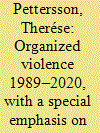

|
|
|
|
|
| Summary/Abstract |
This article reports on trends in organized violence, building on new data by the Uppsala Conflict Data Program (UCDP). The falling trend in fatalities stemming from organized violence in the world, observed for five consecutive years, broke upwards in 2020 and deaths in organized violence seem to have settled on a high plateau. UCDP registered more than 80,100 deaths in organized violence in 2020, compared to 76,300 in 2019. The decrease in violence in Afghanistan and Syria was countered by escalating conflicts in, for example, Artsakh (Nagorno-Karabakh), Azerbaijan and Tigray, Ethiopia. Moreover, the call for a global ceasefire following the outbreak of the COVID-19 pandemic failed to produce any results. In fact, the number of active state-based and non-state conflicts, as well as the number of actors carrying out one-sided violence against civilians, increased when compared to 2019. UCDP noted a record-high number of 56 state-based conflicts in 2020, including eight wars. Most of the conflicts occurred in Africa, as the region registered 30 state-based conflicts, including nine new or restarted ones.
|
|
|
|
|
|
|
|
|
|
|
|
|
|
|
|
| 3 |
ID:
154850
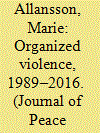

|
|
|
|
|
| Summary/Abstract |
The dramatic increase in the number of fatalities in organized violence, seen between 2011 and 2014, did not continue in 2015 and 2016. Rather, the notation of some 131,000 fatalities in 2014 was followed by a steep decline, with just below 119,000 in 2015 and a little over 102,000 fatalities in 2016. Despite the decrease, the number was the fifth highest during the entire 1989–2016 period. Most of the fatalities – over 87,000 – were incurred in state-based conflicts, the main driver behind the trend. Just as the number of fatalities, the number of state-based conflicts, albeit remaining on a high level, continued to decrease in 2016, going from 52 to 49, with 12 of them reaching the level of war, with at least 1,000 battle-related deaths. Also the non-state conflicts dropped in number in 2016, from 73 to 60. This was followed by a decrease in the number of fatalities, and only one conflict caused more than 1,000 deaths. Twenty-one actors were registered in one-sided violence, down by five from 2015. A number this low has only been recorded twice before; in both 2009 and 2010, 21 one-sided actors were listed in UCDP data. The number of fatalities also decreased, going from almost 9,800 to a little over 6,000.
|
|
|
|
|
|
|
|
|
|
|
|
|
|
|
|
| 4 |
ID:
167284
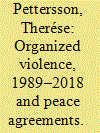

|
|
|
|
|
| Summary/Abstract |
This article reports on trends in organized violence and peace agreements collected by the Uppsala Conflict Data Program (UCDP). The number of fatalities in organized violence decreased for the fourth consecutive year, to reach the lowest level since 2012. In 2018, UCDP recorded almost 76,000 deaths: a decrease of 20% compared to 2017, and 43% compared to the latest peak in 2014. State-based armed conflict drives this downward trend in organized violence, with Syria accounting for much of the change. The number of civilians killed in one-sided violence also dropped in 2018, reaching its lowest level since 2012. In contrast, non-state conflict remained on a high level. The general decline in fatalities from organized violence does not correspond with the trend in the number of active conflicts. In fact, the world has seen a new peak in the number of conflicts after 2014, matched only by the number of conflicts in the early 1990s. In 1991, the peak in the number of armed conflicts corresponded with a similar peak in the number of signed peace agreements. This was followed by a decrease in the number of conflicts in the late 1990s and early 2000s. However, the most recent rise in armed conflicts has not been matched by a similar rise in the number of peace agreements. Two circumstances that characterize the recent rise in conflicts have also been found to make conflicts harder to solve: explicit religious claims and high levels of internationalization.
|
|
|
|
|
|
|
|
|
|
|
|
|
|
|
|
| 5 |
ID:
193115
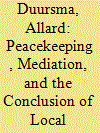

|
|
|
|
|
| Summary/Abstract |
This article theorizes on how military and civilian components of peacekeeping operations contribute to the conclusion of local ceasefires in non-state conflicts involving armed opposition groups or communal groups. A mediation-based logic suggests that civilian peacekeeping staff can provide technical support aimed at resolving the conflict issues and engage with state officials to promote peace. A capabilities-based logic suggest that military peacekeepers can provide security during the negotiations, arrange logistics, and put military pressure on the conflict parties, which all should make the conclusion of a ceasefire more likely. The analysis supports both the capabilities-based and the mediation-based logic. An instrumental variable estimation helps to account for endogeneity. This article contributes to the literature on peacekeeping, mediation, and ceasefires through shifting the focus to non-state conflicts.
|
|
|
|
|
|
|
|
|
|
|
|
|
|
|
|
| 6 |
ID:
142045
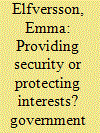

|
|
|
|
|
| Summary/Abstract |
What factors drive governments’ decisions to intervene in local conflicts within their borders? Communal conflict – that is, organized violence between non-state groups that are mobilized along a shared communal identity – kills thousands each year and severely impacts local livelihoods, at times threatening to spread and affect entire regions. Given the state’s assumed monopoly over the legitimate use of force, we should expect the concerned governments to be critical actors of the overall effort to restore peace in cases of local communal conflict, but empirical evidence indicates that central states tend to only intervene in some cases but not in others. This phenomenon has so far been understudied and the variations in states’ efforts to manage these conflicts remain unexplained. This article presents the first quantitative study of state intervention in communal conflicts. Building on existing scholarly work, I argue that state intervention is explained by a combination of strategic interests and state capacity, and that interests related to ethnic constituencies and land control play an important part in explaining governments’ strategies. These propositions find support in a statistical analysis covering sub-Saharan Africa from 1989 to 2010.
|
|
|
|
|
|
|
|
|
|
|
|
|
|
|
|
| 7 |
ID:
108189
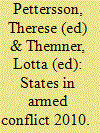

|
|
|
|
|
| Publication |
Uppsala, Uppsala University, Department of peace and conflict research, 2010.
|
| Description |
278p.
|
| Series |
Research report 94
|
| Standard Number |
9789150622492
|
|
|
|
|
|
|
|
|
|
|
|
Copies: C:1/I:0,R:0,Q:0
Circulation
| Accession# | Call# | Current Location | Status | Policy | Location |
| 056310 | 303.6/PET 056310 | Main | On Shelf | General | |
|
|
|
|
|
|
|
|
|